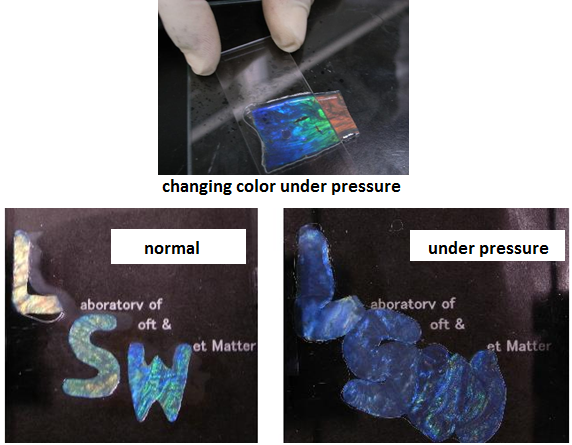Gels with Well-Ordered Structures
Colorful gel
Impressive colors of natural iridescence seen on insects and bird feathers are often the result of hierarchical structures. Peacock feathers are known to have barbules with irregular structures and a macroscopic pattern that enables diffused reflections of structural colors originating from periodic structures of melanin granules with submicron sizes. On the other hand, most artificial photonic crystals with tunable colors possess only regular structures that emit projections of diffraction spots or specular reflections, which are not the same as natural iridescence.
We are studying a hydrogel with tunable structural colors that originated from a superstructure consisting of submicron-scale multilayers, which form a macroscopic Tamagoyaki structure resembling a Japanese rolled-cake style multiple layer omelet. In this gel, polymerized bilayer membranes are periodically orientated in submicron spacing to form a multilayer in which layers of membrane and gel appear alternately. Such a structure shows reflection of iridescent colors essentially by multilayer interference, but in a distinctive pattern due to its Tamagoyaki structure.

PBDT gel
Most soft bio-tissues possess well-ordered structures and are in a soft and wet gel-like state. However, synthesized gels are generally amorphous. To produce structured polymeric hydrogels, liquid crystals (LC) are introduced as dopants because of the possibility of forming self-assembled structures during the polymerization. As LCs, we used poly(2,2′-disulfonyl-4,4′-benzidine terephthalamide) (PBDT), a water-soluble semi-rigid polyanion with a very high molecular weight and a very low critical nematic concentration.
A dual network gel, consisting of micrometer-scale network-like structures of semi-rigid polyion complexes nested in nanometer-scale polycationic networks, has been developed by polymerization of a cationic monomer in the presence of a small amount of PBDT as a dopant. Polymerization produces polycations that interact with oppositely charged semi-rigid PBDT to form complexes through electrostatic interactions. Self-assembly and viscoelastic phase separation of the polyion complexes compete with each other during the polymerization and render the micrometer-scale network-like structure, which is permanently frozen by the subsequent gelation (see Figure).
Additionally, we succeeded in synthesizing hydrogels with uniaxially oriented structures by controlling the diffusional direction of multivalent ions that act as a physical cross-linker in PBDT solutions. Furthermore, using the DN technique, we synthesized highly ordered DN gels possessing excellent mechanical properties, particularly high extensibility, which exceeded 2200% of its original length under uniaxial elongation (see Figure, the left is the microstructure observed by SEM, the right is the elongation test of the gel).

